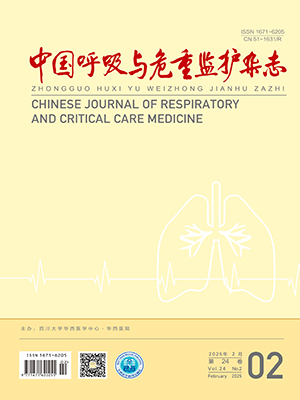| 1. |
Gao R, Cao B, Hu Y, et al. Human infection with a novel avian-origin influenza A (H7N9) virus. N Engl J Med, 2013, 368(20): 1888-1897.
|
| 2. |
世界卫生组织. 人感染甲型 H7N9 禽流感病毒——中国. (2018-06-13)[2018/6/13]. http://www.who.int/csr/don/20-april-2017-ah7n9-china/zh/.
|
| 3. |
Xiang NJ, Li XY, Ren RQ, et al. Assessing change in avian influenza A (H7N9) virus infections during the fourth epidemic -- China, September 2015-August 2016. Morb Mortal Wkly Rep, 2016, 65(49): 1390-1394.
|
| 4. |
Zhou L, Ren R, Yang L, et al. Sudden increase in human infection with avian influenza A (H7N9) virus in China, September-December 2016. Western Pac Surveill Response J, 2017, 8(1): 6-14.
|
| 5. |
国家卫生和计划生育委员会. 人感染 H7N9 禽流感诊疗方案(2017 年第 1 版). 中国病毒病杂志, 2017, 7(1): 1-4.
|
| 6. |
Tan KX, Jacob SA, Chan KG, et al. An overview of the characteristics of the novel avian influenza A H7N9 virus in humans. Front Microbiol, 2015, 6(140): 140-151.
|
| 7. |
刘国贤, 刘荣强, 王正良, 等. 一起家庭聚集性人感染 H7N9 禽流感事件调查. 实用预防医学, 2015, 22(7): 826-828.
|
| 8. |
钟群, 高立冬, 陈伯中, 等. 一起家庭聚集性人感染 H7N9 禽流感疫情的流行病学调查. 实用预防医学, 2017, 24(9): 1140-1142.
|
| 9. |
Li Q, Zhou L, Zhou M, et al. Epidemiology of human infections with avian influenza A (H7N9) virus in China. N Engl J Med, 2014, 370(6): 520-532.
|
| 10. |
华伟玉, 刘锋, 孙亚敏, 等. 一例儿童轻型人感染 H7N9 禽流感确诊病例调查. 国际病毒学杂志, 2015, 22(1): 62-64.
|
| 11. |
曾玫, 朱燕凤, 葛艳玲, 等. 中国确诊的首例儿童 H7N9 禽流感. 中华儿科杂志, 2013, 51(9): 665-669.
|
| 12. |
Wang C, Yu H, Horby PW, et al. Comparison of patients hospitalized with influenza A subtypes H7N9, H5N1, and 2009 pandemic H1N1. Clin Infect Dis, 2014, 58(8): 1095-1103.
|
| 13. |
Yang ZF, Mok CK, Liu XQ, et al. Clinical, virological and immunological features from patients infected with re-emergent avian-origin human H7N9 influenza disease of varying severity in Guangdong province. PLoS One, 2015, 10(2): e117846.
|
| 14. |
Wu W, Shi D, Fang D, et al. A new perspective on C-reactive protein in H7N9 infections. Int J Infect Dis, 2016, 44(C): 31-36.
|
| 15. |
徐冲, 董丽霞, 曹洁. 降钙素原在社区获得性肺炎预后评估中的价值. 中国呼吸与危重监护杂志, 2017, 16(2): 117-121.
|
| 16. |
Poddar B, Gurjar M, Singh S, et al. Reduction in procalcitonin level and outcome in critically ill children with severe sepsis/septic shock-A pilot study. J Crit Care, 2016, 36(2016): 230-233.
|
| 17. |
Leung YH, To MK, Lam TS, et al. Epidemiology of human influenza A(H7N9) infection in Hong Kong. J Microbiol Immunol Infect, 2015, 2(50): 183-188.
|
| 18. |
Cao B, Gao H, Zhou B, et al. Adjuvant corticosteroid treatment in adults with influenza A (H7N9) viral pneumonia. Crit Care Med, 2016, 44(6): e318-e328.
|
| 19. |
Hu Y, Lu S, Song Z, et al. Association between adverse clinical outcome in human disease caused by novel influenza A H7N9 virus and sustained viral shedding and emergence of antiviral resistance. Lancet, 2013, 381(9885): 2273-2279.
|
| 20. |
Smee DF, Hurst BL, Wong MH, et al. Combinations of oseltamivir and peramivir for the treatment of influenza A (H1N1) virus infections in cell culture and in mice. Antiviral Res, 2010, 88(1): 38-44.
|
| 21. |
Zhang Y, Gao H, Liang W, et al. Efficacy of oseltamivir-peramivir combination therapy compared to oseltamivir monotherapy for Influenza A (H7N9) infection: a retrospective study. BMC Infect Dis, 2016, 16(1): 76-84.
|
| 22. |
Pizzorno A, Abed Y, Rhéaume C, et al. Oseltamivir-zanamivir combination therapy is not superior to zanamivir monotherapy in mice infected with influenza A(H3N2) and A(H1N1)pdm09 viruses. Antiviral Res, 2014, 105(3): 54-58.
|




